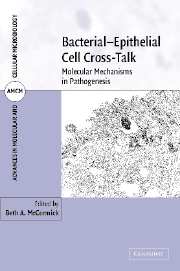Book contents
- Frontmatter
- Contents
- List of contributors
- Part I Introduction to the host and bacterial pathogens
- Part II Bacterial cell biology and pathogenesis
- Part III Host cell signaling by bacteria
- 8 Host-mediated invasion: the Salmonella Typhimurium trigger
- 9 NF-κB-dependent responses activated by bacterial–epithelial interactions
- 10 NF-kB-independent responses activated by bacterial–epithelial interactions: the role of arachidonic acid metabolites
- Part IV Exploitation of host niches by pathogenic bacteria: mechanisms and consequences
- Index
- Plate section
- References
10 - NF-kB-independent responses activated by bacterial–epithelial interactions: the role of arachidonic acid metabolites
from Part III - Host cell signaling by bacteria
Published online by Cambridge University Press: 12 August 2009
- Frontmatter
- Contents
- List of contributors
- Part I Introduction to the host and bacterial pathogens
- Part II Bacterial cell biology and pathogenesis
- Part III Host cell signaling by bacteria
- 8 Host-mediated invasion: the Salmonella Typhimurium trigger
- 9 NF-κB-dependent responses activated by bacterial–epithelial interactions
- 10 NF-kB-independent responses activated by bacterial–epithelial interactions: the role of arachidonic acid metabolites
- Part IV Exploitation of host niches by pathogenic bacteria: mechanisms and consequences
- Index
- Plate section
- References
Summary
INTRODUCTION
Lipid membranes and the individual lipids that comprise them were initially considered to solely provide eukaryotic cells with organized hydrophobic barriers used to separate cytoplasmic and extracellular environments. Additional studies demonstrated that these lipid bilayer structures also acted as boundaries for discrete intracellular structures, e.g. mitochondria, endosomes, and endoplasmic reticulum. Although this capacity to separate aqueous compartments clearly is an essential feature of normal cell structure and function, more recent studies have demonstrated that lipid components in these bilayer membranes also provide cells with substrates to produce a spectrum of intra- and extracellular messengers. Metabolism of membrane lipid components has been shown to produce bioactive lipids that participate in numerous signaling mechanisms. Many of these bioactive lipids, such as prostaglandins, leukotrienes, hydroperoxy acids, hepoxilins, lipoxins, and thromboxanes, are derived from the metabolic processing of arachidonic acid.
Arachadonic acid, a 20-carbon fatty acid that contains four carbon–carbon double bonds, is the precursor substrate used for the production of a large family of bioactive lipids known as eicosanoids (Fitzpatrick and Soberman, 2001; Lieb, 2001) (Figure 10.1). By itself, arachidonic acid can act as a second messenger by its ability to interact with GTP-binding proteins (Abramson et al.., 1991), inhibit GTPase-activating protein regulated by RAS (Ras-GAP) function (Han et al., 1991), cause the release of Ca2+ ions stored in the sarcoplasmic reticulum (Dettbarn and Palade, 1993), and modulate protein kinase C (PKC) activity (Khan et al., 1995).
- Type
- Chapter
- Information
- Bacterial-Epithelial Cell Cross-TalkMolecular Mechanisms in Pathogenesis, pp. 269 - 298Publisher: Cambridge University PressPrint publication year: 2006
References
- 1
- Cited by



